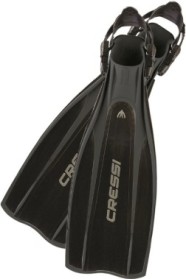Last Updated on May 19, 2021 by Dan
Divers are a unique bunch. We all have our own preferences when it comes to diving gear, and no one is ever fully prepared for the next adventure unless they have every type of equipment available. One of the most important pieces of equipment that divers need is their fins, but how many pairs should you actually own?
The answer depends on your personal preference and what kind of diving you will be doing. If you dive in cold water with heavy wetsuits, then more than two may not be necessary (depending on your height). But if you dive in warm tropical water without a wetsuit, then three or four would probably be sufficient. For those who know exactly where their next diving destination will be before they leave home there are many different fins on the market that are designed for specific diving conditions.
With all the bells and whistles of technologies in fin designs to suit kicking styles. (eg, split fins, jet fins etc)
Just how many pairs or types of fins is really enough?
If you plan to dive with a buddy, each diver should have a few pairs so that they’re not dependent on their partner’s gear in case something happens during the dive and it needs to be abandoned (like if your buoyancy control device malfunctions). My recommendation would be four pairs of fins depending on where and how much time you want to spend underwater.
Popular Fins:
Tusa Xpert Zoom
ScubaPro Nova Seawings – great for travel
Force Fin Pro
Voit UDT
ScubaPro Yellow Jet
ScubaPro Jet
Mares Avanti Quattro
Voit Skindiver
Nemrod Super A Professional
Oms slipstreams
Power fins
Oceanic split fins
Akona marathons
Edge full foot snorkeling fins
Dive rites
Atomic split fins
Hollis f1s fins
Additional Tips
If you’re into spearfishing, then a single pair of split fins with detachable blades will do the trick.
Diving in shallow water (less than 12 ft) is a great time to use those full foot snorkeling fins since they provide more propulsion and power. This allows for better maneuverability and less difficulty when trying to weed through kelp or other underwater plants while looking for that tasty lobster dinner!
Full steel-toed boots are necessary if diving in deeper waters as your toes may get caught on something like an old anchor line. The last thing anyone wants is their big toe getting severed off by not wearing proper protection! If using traditional scuba gear like double tanks, regulators, etc., make sure you have a backup regulator and plenty of air on hand.
Quick Tip: If going diving in deep waters with traditional SCUBA equipment such as double tanks and regulators, make sure all systems are tested prior to entering the water! Additionally, always remember to bring enough air for the dive since it’s very easy to get lost undersea without any way out from exhaustion.
The takeaway is this: make sure you always bring your dive gear with you when traveling to a destination where recreational scuba diving is possible! The more equipment, in general, the better. It’s never good to be unprepared or underprepared when it comes to any outdoor activity–especially one as potentially dangerous as underwater adventure.
The average number of fins owned by recreational divers in a Scuba diving forum would be four pairs of fins depending on where and how much time you want to spend underwater.

